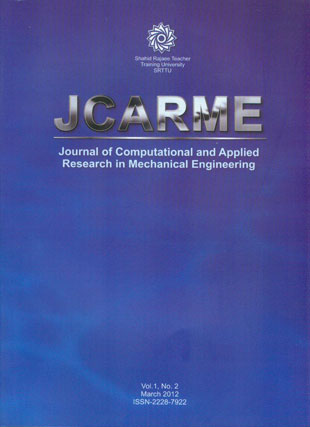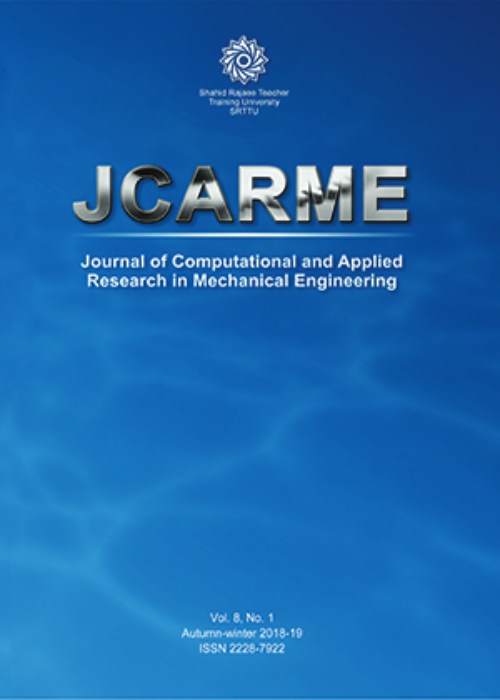فهرست مطالب

Journal of Computational and Applied Research in Mechanical Engineering
Volume:1 Issue: 2, Spring 2012
- تاریخ انتشار: 1390/12/28
- تعداد عناوین: 7
-
-
Page 69The technique used to control the airflow is based on the electro-hydrodynamic actuator which is also called plasma actuator. This actuator ensures the airflow control thanks to the electric wind created by the electrical corona discharge. This ionic wind is developed at the profile surface tangential to the initial free airflow so that it has a significant effect on the boundary layer flow. The studied profile was a NACA4412 airfoil. The electro-hydrodynamic actuator was placed at the surface of the NACA profile. The PIV visualizations made at angle of attack of 18° show an earlier flow reattachment to the profile surface when the plasma actuator is active. PIV measurements confirm that downstream of the actuator, when the discharge is ON, the wall velocity gradient is increased as illustrated by the velocity profiles taken at several positions on the NACA4412 wall. Then the plasma actuator can decrease the boundary layer thickness.
-
Page 77This paper deals with a multi-period fixed charge production-distribution problem associated with backorder and inventories. The objective is to determine the size of the shipments from each supplier and backorder and inventories at each period, so that the total cost incurred during the entire period towards production, transportation, backorder and inventories is minimised. A 0-1 mixed integer programming problem is formulated. Genetic algorithm based population search heuristic, Simulated annealing based neighbourhood search heuristic and Equivalent variable cost based simple heuristic are proposed to solve the formulation. The proposed methodologies are evaluated by comparing their solutions with the lower bound solutions. The comparisons reveal that Genetic algorithm and Simulated annealing algorithm generate better solutions than the Equivalent variable cost solutions and are capable of providing solutions close to the lower bound value of the problems.
-
Page 89In this paper, a monotone positive solution is studied for buckling of a distributed model of multi walled carbon nanotube (MWCNT) cantilevers in the vicinity of thin and thick graphite sheets subject to intermolecular forces. In the modeling of intermolecular forces, Van der Waals forces are taken into account. A hybrid nano-scale continuum model based on Lennard–Jones potential is applied to simulate the intermolecular force-induced deflection of MWCNT. A positive monotone solution based on Green’s function in the form of a nonlinear iterative integral is introduced to obtain a solution for deflection of MWCNT cantilevers. In order to determine the accuracy of the presented method, the results are compared with numerical results of a numerical method as well as other methods reported in the literature. The results show that the monotone iterative solution is stable and converged to numerical results with a few iterations. The results of the present work are useful to prove the stability and convergence of Green’s function to deal with deflection of nano cantilever actuators in future works and simplifications.
-
Page 99
Experiments were conducted to evaluate the performance of a low heat rejection (LHR) diesel engine. Performance parameters and emission levels were determined at various magnitudes of brake mean effective pressure. Combustion characteristics of the engine were measured with TDC (top dead centre) encoder, pressure transducer, console and special pressure-crank angle software package at peak load operation of the engine. Conventional engine (CE) and LHR engine showed improved performance at recommended injection timing of 27obTDC and recommended injection pressure of 190 bar, when compared with CE with pure diesel operation. Peak brake thermal efficiency increased by 18%, smoke levels decreased by 48% and NOx levels decreased by 38% with LHR engine relatively at its optimum injection timing and maximum induction of ethanol when compared with pure diesel operation of CE at manufacturer’s recommended injection timing.
-
Page 111Over the last ten years, robustness of schemes has raised an increasing interest among the CFD community. The objective of this article is to solve the quasione- dimensional compressible flow inside a “Shubin nozzle” and to investigate Bean-Warming and flux vector splitting methods for numerical solution of compressible flows. Two different conditions have been considered: first, there is a supersonic flow in the entry and a supersonic flow in the outlet, without any shock in the nozzle. Second, there is a supersonic flow in the inlet and a subsonic flow in the outlet of the nozzle and a shock occur inside the nozzle. The results show that the run time of the flux vector splitting scheme is more than the Bean- Warming scheme, and, the flux vector splitting scheme is more accurate than the Bean-Warming scheme. However the flux vector splitting scheme is more complicated.
-
Effects of asymmetric stiffness on parametric instabilities of rotor Chandan Kumar and Vikas RastogiPage 119This work deals with effects of asymmetric stiffness on the dynamic behaviour of the rotor system. The analysis is presented through an extended Lagrangian Hamiltonian mechanics on the asymmetric rotor system, where symmetries are broken in terms of the rotor stiffness. The complete dynamics of asymmetries of rotor system is investigated with a case study. In this work, a mathematical model is developed considering symmetry breaking of a finite rotor due to stiffness. The natural frequency and amplitude of the rotor are obtained analytically through extended Lagrangian formulation. The asymmetries in rotor are also modeled through bond graph modeling technique for the computational analysis. The simulation result shows a considerable agreement with the analytical results. The limiting dynamics of rotor is shown and analyzed through simulation.
-
Page 129The motivation for this work is to propose a first thorough review of dough rheological models used in numerical applications. Although many models have been developed to describe dough rheological characteristics, few of them are employed by researchers in numerical applications. This article reviews them in detail and attempts to provide new insight into the use of dough rheological models.


